
A male giant sea bass nudges a female giant sea bass to encourage spawning as they swim in a tight circle. This courting pair of giant sea bass is deep in the kelp forest at Catalina Island. In summer months, giant sea bass gather in kelp forests in California to form courtship and mating aggregations, eventually leading to spawning.
Species: Giant black sea bass, Stereolepis gigas
Location: Catalina Island, California
Image ID: 33364
Species: Giant black sea bass, Stereolepis gigas
Location: Catalina Island, California
Image ID: 33364

Giant black sea bass, endangered species, reaching up to 8' in length and 500 lbs, amid giant kelp forest.
Species: Giant black sea bass, Stereolepis gigas
Location: Catalina Island, California
Image ID: 33378
Species: Giant black sea bass, Stereolepis gigas
Location: Catalina Island, California
Image ID: 33378

Giant black sea bass, gathering in a mating - courtship aggregation amid kelp forest, Catalina Island.
Species: Giant black sea bass, Stereolepis gigas
Location: Catalina Island, California
Image ID: 33379
Species: Giant black sea bass, Stereolepis gigas
Location: Catalina Island, California
Image ID: 33379
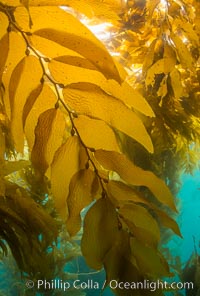
Giant kelp frond showing pneumatocysts. Small gas bladders -- pneumatocysts -- connect the kelp's stipes ("stems") to its blades ("leaves"). These bladders help elevate the kelp plant from the bottom, towards sunlight and the water's surface.
Species: Giant kelp, Macrocystis pyrifera
Location: Catalina Island, California
Image ID: 33439
Species: Giant kelp, Macrocystis pyrifera
Location: Catalina Island, California
Image ID: 33439
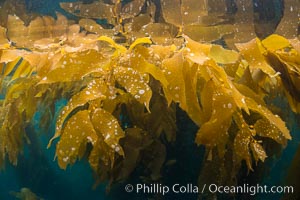
Giant kelp frond showing pneumatocysts. Small gas bladders -- pneumatocysts -- connect the kelp's stipes ("stems") to its blades ("leaves"). These bladders help elevate the kelp plant from the bottom, towards sunlight and the water's surface.
Species: Giant kelp, Macrocystis pyrifera
Location: Catalina Island, California
Image ID: 33440
Species: Giant kelp, Macrocystis pyrifera
Location: Catalina Island, California
Image ID: 33440

Sunlight streams through giant kelp forest. Giant kelp, the fastest growing plant on Earth, reaches from the rocky reef to the ocean's surface like a submarine forest.
Species: Giant kelp, Macrocystis pyrifera
Location: Catalina Island, California
Image ID: 33441
Species: Giant kelp, Macrocystis pyrifera
Location: Catalina Island, California
Image ID: 33441
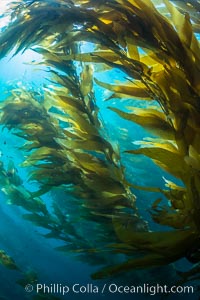
Sunlight streams through giant kelp forest. Giant kelp, the fastest growing plant on Earth, reaches from the rocky reef to the ocean's surface like a submarine forest.
Species: Giant kelp, Macrocystis pyrifera
Location: Catalina Island, California
Image ID: 33442
Species: Giant kelp, Macrocystis pyrifera
Location: Catalina Island, California
Image ID: 33442

Sunlight streams through giant kelp forest. Giant kelp, the fastest growing plant on Earth, reaches from the rocky reef to the ocean's surface like a submarine forest.
Species: Giant kelp, Macrocystis pyrifera
Location: Catalina Island, California
Image ID: 33443
Species: Giant kelp, Macrocystis pyrifera
Location: Catalina Island, California
Image ID: 33443

Sunlight streams through giant kelp forest. Giant kelp, the fastest growing plant on Earth, reaches from the rocky reef to the ocean's surface like a submarine forest.
Species: Giant kelp, Macrocystis pyrifera
Location: Catalina Island, California
Image ID: 33444
Species: Giant kelp, Macrocystis pyrifera
Location: Catalina Island, California
Image ID: 33444
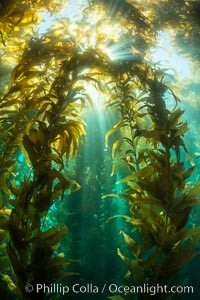
Sunlight streams through giant kelp forest. Giant kelp, the fastest growing plant on Earth, reaches from the rocky reef to the ocean's surface like a submarine forest.
Species: Giant kelp, Macrocystis pyrifera
Location: Catalina Island, California
Image ID: 33445
Species: Giant kelp, Macrocystis pyrifera
Location: Catalina Island, California
Image ID: 33445

Sunlight streams through giant kelp forest. Giant kelp, the fastest growing plant on Earth, reaches from the rocky reef to the ocean's surface like a submarine forest.
Species: Giant kelp, Macrocystis pyrifera
Location: Catalina Island, California
Image ID: 33446
Species: Giant kelp, Macrocystis pyrifera
Location: Catalina Island, California
Image ID: 33446

Kelp holdfast attaches the plant to the rocky reef on the oceans bottom. Kelp blades are visible above the holdfast, swaying in the current.
Location: Catalina Island, California
Image ID: 34212
Location: Catalina Island, California
Image ID: 34212

A giant black sea bass is an endangered species that can reach up to 8 feet in length and 500 pounds, often found amid the giant kelp forest, Once nearly fished to extinction and now thought to be at risk of a genetic bottleneck, the giant sea bass is slowly recovering and can be seen in summer months in California's kelp forests.
Species: Giant black sea bass, Stereolepis gigas
Location: Catalina Island, California
Image ID: 34616
Species: Giant black sea bass, Stereolepis gigas
Location: Catalina Island, California
Image ID: 34616
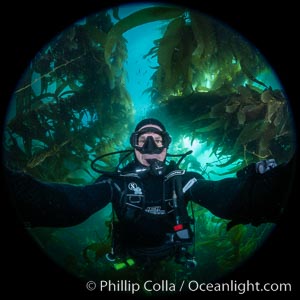
Selfie, giant kelp forest, Catalina Island.
Species: Giant kelp, Macrocystis pyrifera
Location: Catalina Island, California
Image ID: 37296
Species: Giant kelp, Macrocystis pyrifera
Location: Catalina Island, California
Image ID: 37296

Garibaldi and golden gorgonian, with a underwater forest of giant kelp rising in the background, underwater.
Species: California golden gorgonian, Garibaldi, Hypsypops rubicundus, Muricea californica
Location: San Clemente Island, California
Image ID: 37097
Species: California golden gorgonian, Garibaldi, Hypsypops rubicundus, Muricea californica
Location: San Clemente Island, California
Image ID: 37097

Giant black sea bass, endangered species, reaching up to 8' in length and 500 lbs, amid giant kelp forest.
Species: Giant black sea bass, Stereolepis gigas
Location: Catalina Island, California
Image ID: 33370
Species: Giant black sea bass, Stereolepis gigas
Location: Catalina Island, California
Image ID: 33370

Drift kelp, a kelp paddy, floating patch of kelp on the open ocean which attracts marine life and forms of moving oasis of life, an open ocean habitat, aerial photo.
Species: Giant kelp, Macrocystis pyrifera
Location: California
Image ID: 29083
Species: Giant kelp, Macrocystis pyrifera
Location: California
Image ID: 29083
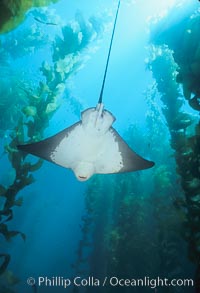
California bat ray in kelp forest.
Species: California bat ray, Macrocystis pyrifera, Myliobatis californica
Location: San Clemente Island, California
Image ID: 00267
Species: California bat ray, Macrocystis pyrifera, Myliobatis californica
Location: San Clemente Island, California
Image ID: 00267

Garibaldi in kelp forest.
Species: Garibaldi, Hypsypops rubicundus, Macrocystis pyrifera
Location: San Clemente Island, California
Image ID: 01055
Species: Garibaldi, Hypsypops rubicundus, Macrocystis pyrifera
Location: San Clemente Island, California
Image ID: 01055

Blue shark and offshore drift kelp paddy, open ocean.
Species: Blue shark, Macrocystis pyrifera, Prionace glauca
Location: San Diego, California
Image ID: 01077
Species: Blue shark, Macrocystis pyrifera, Prionace glauca
Location: San Diego, California
Image ID: 01077

Blue shark and offshore drift kelp.
Species: Blue shark, Macrocystis pyrifera, Prionace glauca
Location: San Diego, California
Image ID: 01082
Species: Blue shark, Macrocystis pyrifera, Prionace glauca
Location: San Diego, California
Image ID: 01082

Blue shark and offshore drift kelp paddy, open ocean.
Species: Blue shark, Macrocystis pyrifera, Prionace glauca
Location: San Diego, California
Image ID: 01153
Species: Blue shark, Macrocystis pyrifera, Prionace glauca
Location: San Diego, California
Image ID: 01153

Giant kelp, blades, stipes and pneumatocysts, backlit by the sun in shallow water.
Species: Giant kelp, Macrocystis pyrifera
Location: San Clemente Island, California
Image ID: 25401
Species: Giant kelp, Macrocystis pyrifera
Location: San Clemente Island, California
Image ID: 25401

Boat Horizon above kelp forest.
Species: Giant kelp, Macrocystis pyrifera
Location: San Clemente Island, California
Image ID: 03764
Species: Giant kelp, Macrocystis pyrifera
Location: San Clemente Island, California
Image ID: 03764

Macrocystis kelp growing up from a rocky reef, the kelp's holdfast is like a root cluster which attaches the kelp to the rocky reef on the oceans bottom. Kelp blades are visible above the holdfast, swaying in the current.
Species: Giant kelp, Macrocystis pyrifera
Location: San Clemente Island, California
Image ID: 37053
Species: Giant kelp, Macrocystis pyrifera
Location: San Clemente Island, California
Image ID: 37053
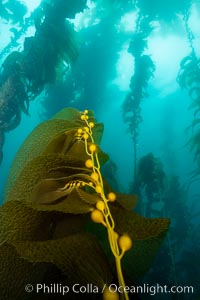
Kelp fronds and pneumatocysts. Pneumatocysts, gas-filled bladders, float the kelp plant off the ocean bottom toward the surface and sunlight, where the leaf-like blades and stipes of the kelp plant grow fastest. Giant kelp can grow up to 2' in a single day given optimal conditions. Epic submarine forests of kelp grow throughout California's Southern Channel Islands.
Species: Giant kelp, Macrocystis pyrifera
Location: San Clemente Island, California
Image ID: 37054
Species: Giant kelp, Macrocystis pyrifera
Location: San Clemente Island, California
Image ID: 37054

Kelp fronds and pneumatocysts. Pneumatocysts, gas-filled bladders, float the kelp plant off the ocean bottom toward the surface and sunlight, where the leaf-like blades and stipes of the kelp plant grow fastest. Giant kelp can grow up to 2' in a single day given optimal conditions. Epic submarine forests of kelp grow throughout California's Southern Channel Islands.
Species: Giant kelp, Macrocystis pyrifera
Location: San Clemente Island, California
Image ID: 37076
Species: Giant kelp, Macrocystis pyrifera
Location: San Clemente Island, California
Image ID: 37076

Sheephead wrasse, Garibaldi and golden gorgonian, with a underwater forest of giant kelp rising in the background, underwater.
Species: California golden gorgonian, Garibaldi, Hypsypops rubicundus, Muricea californica
Location: San Clemente Island, California
Image ID: 37093
Species: California golden gorgonian, Garibaldi, Hypsypops rubicundus, Muricea californica
Location: San Clemente Island, California
Image ID: 37093

Kelp fronds and pneumatocysts. Pneumatocysts, gas-filled bladders, float the kelp plant off the ocean bottom toward the surface and sunlight, where the leaf-like blades and stipes of the kelp plant grow fastest. Giant kelp can grow up to 2' in a single day given optimal conditions. Epic submarine forests of kelp grow throughout California's Southern Channel Islands.
Species: Giant kelp, Macrocystis pyrifera
Location: San Clemente Island, California
Image ID: 37101
Species: Giant kelp, Macrocystis pyrifera
Location: San Clemente Island, California
Image ID: 37101
